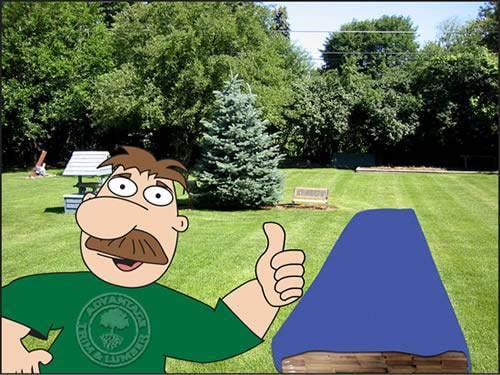
Doug Tales – Cover The Decking, Ruin the Wood
The story you are about to read is true and, unfortunately, all too common…
Doug’s order of wood decking has just arrived. Needless to say, he’s very excited. Even though the sky is clear, Doug knows that it’s going to rain overnight. So he covers it with a tarp so that the wood can be protected prior to installation.
The next day, it’s sunny and clear again. Doug says, “Time to get building!”
He removes the tarp from the pile, “So far, so good.”
As Doug starts prepping the wood, he notices that some boards are a little warped. He thinks to himself, “What gives? I thought this stuff was supposed to be strong!? Oh well, I bought a deck wrench, I’ll just straighten up out. No worries.”
A couple of hours later, Doug’s wife comes out to see how things are going, “Um, honey. What did you do?”
Try as he might to ignore it, Doug can’t any longer. Nearly all the decking is checked, some have pronounced splits, and many boards are warped. Doug assures his wife, “It’s GOTTA be the wood. I’ll get the supplier on the phone right now.”
He calls his lumber supplier. “Hi. Um, this wood you sold me is defective. What gives? It’s starting to split at the ends and a lot of boards now look like archery bows! I want an explanation!”
Because Doug bought the decking from a reputable supplier (they even gave him a shirt!), he is told, “Sir, I understand your frustration. Calling us was the right thing to do. Can you tell me the condition of the wood when it first arrived at the job site and what you did with it when it arrived?”
He tells them how the wood arrived and each step he took to prepare it for installation, “Each board looked great off the truck. I covered it with a plastic tarp to protect it from the thunderstorm last night.” The manager on the other line says, “Sir, the problem the wood is experiencing will happen anytime wood that has not yet acclimated to an environment is covered for any length of time.”
Doug’s reaction is understandable, “Um, what? I was just trying to protect the wood.”
“Well sir, you see when wood is covered with a tarp, the result is a greenhouse effect. Moisture gets trapped under the tarp, the wood absorbs the moisture, and once the tarp is lifted, the grain in the wood naturally releases the excess moisture at a rapid pace. That is what leads to the checking and warping the wood is currently experiencing. Now, the wood we sold you did have the end grains covered, but that would not have prevented the moisture from being trapped under the tarp and that scientific process from occurring. It’s important to remember that your deck will always be exposed to the elements. The best way to protect it is to use a deck oil, and seal fresh cuts with an end grain sealant.”
Doug, almost in a panic asks, “What do i do now? Is there a way to save it?”
The manager at the decking supplier tells Doug to:
- Cut off checks
- Re-apply end-seal as needed
- Use Hardwood Wrench™ deck tool to help with warped boards
- Measure the boards you just cut and order more decking
- When the new decking arrives, allow at least 4-5 days to pass before installing
Needless to say, Doug is relieved. His wife? Not so much. You can just imagine the earful he’s gonna get when he tells her the news…let’s just hope that he doesn’t make another mistake!
The lesson? Unless a tornado is about to blow through your backyard, don’t cover your decking. Allow at least 4-5 days for it to acclimate outdoors to your area’s climate. Then apply end seal to every end you cut to ensure that the wood doesn’t check or split. Learn more about decking installation.
Do you have a deck building story to share? Use to comment form below to share your deck building experiences with others.
1 thought on “DIY Deck Installation Tips #1 – How Not to Handle New Decking”